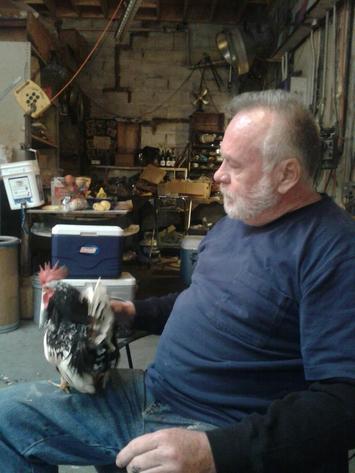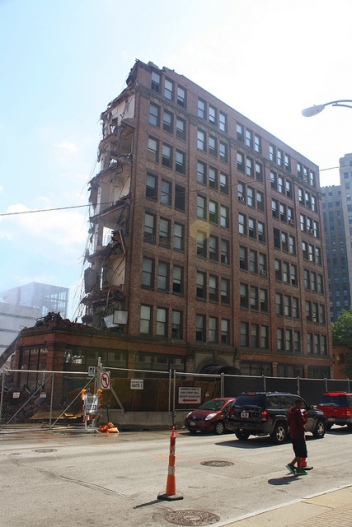
“Indeed, we have the know-how, but we do not have the know-why, nor the know-what-for”—Erich Fromm, social psychologist.
The question of how you “become” as a city has been weighing on me lately. Is it enough to get people back into the emptiness? Is it enough to pretty the derelict? I mean, is the trajectory of Cleveland’s success simply a collection of micro-everythings, start-ups, and occupancy rates? That is, is Cleveland’s reward simply the benefit of being creatively classed?
I hope not. It won’t work. Here is why.
The problem with most city revitalization these days relates to its playbook: there are the investors who have the capital, and then the political power from which finance flows. Here, money not only talks, it builds, with investors’ wishes transcribed in how a city looks, feels, and functions. That said, the main interest of the investors is to make money, and so people are seen as consumers as opposed to citizens. Consumers that fill up real estate space. Consumers that salivate over tastes. Consumers of art and design, with the attraction to beauty meant to establish a “vibrancy for profit” mindset as opposed to experiencing beauty for the value of beauty’s sake. Come to think of it, the creative class is really just the consumer class, just like the rest of us. Yet they are anointed in status by city makers because they are thought to have more spending power than their working- and service-class counterparts.
“Follow the creative community, and property values will rise,” states one recent article in a real estate publication. “You have given real estate developers the playbook”, echoes Albert Ratner, head of Cleveland-based Forest City, on his reading of “The Rise of the Creative Class”. The motivations, as such, are quite blatant.
Now, why is this a problem?
Because developers have extraordinary amounts of pull in directing where finances goes (this is particularly true in Cleveland), which means investment can get skewed to a select demographic. As such, the gap between the haves and have not’s grows and the geographic disparities begin to cement social inequities into the city’s fabric. Cracks then show: drug use, murders, alienation and disenfranchisement, growing pockets of continued disinvestment, and it won’t stop because research has consistently shown that inequity is an endless source of social ills. The only thing left to do is to compartmentalize our shadows, with “bad” kept in places away from the spots of our “hope”. This is not unique to Cleveland or to this era. It is just the way things have been, which leads me to wonder if Cleveland’s recent comeback is just a carousel in which progress is simply rearranging the broken deckchairs.
But while the future is uncertain, failure need not be inevitable. Yet what can be done in Cleveland and other Rust Belt cities to ensure we don’t waste our opportunity? Unfortunately, little outside of a radical shift in how cities think about themselves, particularly as it relates to the notion of “revitalization”.
This is where the concept of “Rust Belt Chic” comes in, which—when it is boiled down—is really just a process of collectively “knowing thyself” (an in depth description of Rust Belt Chic economic development will be delineated in a subsequent post). Specifically, by becoming aware of who we are as “Cleveland” we know who we are not, or more exactly: what we don’t need to be. This is important as it relieves the temptation of Cleveland trying to copy some other city’s so-called success which, in the end, is counterproductive, as such efforts—like the historic Columbia Building demolition for a Vegas-style “look”—ultimately eliminates those things like history and architecture which ties us together.
This is all to say that Cleveland need not be “brochured” for the so-called creative class. That is simply objectifying your city as a product as opposed to a people, which is crude, and such posturing and posing is hardly Cleveland, besides.
Instead, a hammering down of who we are in our process of becoming is needed. We are Clevelanders. We care and fight for this city, endlessly. We swear, shake hands, bleed, heal, work, fight, and pray—all in an environment molded more so by the reality of Mickey Rourke than the donning of Ashton Kutcher. And so while repopulating the core is needed, we also must engage in building the productive capacity of people as opposed to simply relying on a capacity to spend. Specifically, squeezing out price per sq. feet at the expense of community fabric is not true economic growth. It is mountains turned to coal.
I cannot emphasize enough how important community development is to Cleveland’s future. For as creative classification goes main stream, more and more cities will begin looking and feeling the same, and more and more cities will be turned to products to be gobbled up by those with stars in their eyes. But this kind of thing is not for everyone, or even for most. It is for a slice, a finicky slice. And so I gather creative classification will go the way of the fad, like all styles do. Some cities will be stuck left to look at the cartoon tattoos that dot their body, while the people left longing will decompress to find something a little more real.
Then—if we do it right—people will turn to Cleveland not because we faked the place as attractive, but because Cleveland made an effort to turn to its people.
This post originally appeared at Cool Cleveland.
Richey Piiparinen is a writer and policy researcher based in Cleveland. He is co-editor of Rust Belt Chic: The Cleveland Anthology. Read more from him at his blog and at Rust Belt Chic.
Lead photo: Don’t call him creative classed. A Cleveland artist, Mac, and his rooster, Morty.














Opportunity and "Cui Bono?"
Jane Jacobs always asserted that most of the creativity in well-established cities, occurred in the "interstices" between the skyscrapers and glittering new developments, where dilapidated old buildings were still available at rents that were affordable to the "less-well-heeled but still creative" class of people.
I strongly agree that the property investor class should not be allowed to benefit from public spending that boosts the value of their investments while lumbering costs on people who will not benefit. The classic example is rail based transit "investments" paid for by the region's and the nation's taxpayers. The CBD property owners who benefit do not care if the benefit cost ratio is $1 of benefit and $8 of cost, as long as they are capturing the $1 of benefit and only paying 20 cents of the cost, if that.
Public money spent on convention centres and stadiums are further examples.
Projects like these should be paid for by special assessment levies on the owners of properties that benefit from them. If it is not worth it to these property owners to pay the special assessment levies to enable the projects to proceed, then it most certainly is not worth it for the local economy as a whole.
There is a major difference between the USA's "Rust Belt" including Detroit, and the UK's one. The UK's one is never going to recover, because the UK's strict urban planning system ensures relentless unaffordability of urban land even in economic disaster zones. The conditions in which the singing sensation Susan Boyle existed, shocked many international viewers; but this is the norm for millions of people in Britain.
The UK has London, a centre of global capital and also the Capital city whence all taxpayer funds flow. And that is about it. The rest of the UK is bumping along trying to survive with niche industries that are not incompatible with relentlessly high urban land costs.
But the USA has variety; it has the global finance too, in a few centres; AND it has numerous highly competitive-land-cost cities attracting manufacturing and the less-well-heeled creative class. The so-called attraction of the creative class to "Superstar cities" with lots of planning-related amenities and "de facto gated community" level housing prices, is grossly over-rated; ultimately the rent has to be paid, and you might just "price out" the next Bill Gates from your local economy.
THIS should have the proponents of such cities seriously worried:
http://www.newgeography.com/content/003007-the-us-cities-getting-smarter...
The UK economy desperately needs a Houston and even a Detroit. It has dozens of cities that ARE "Detroit" but with unaffordable housing, even though that housing consists of grimy old attached dwellings with no gardens or backyards. And there are also eyesore "disused" industrial structures that no-one can afford to redevelop or put to use. Even the "interstices" are unaffordable.....!
At least the USA's rust belt has "opportunity", which is precisely how free markets are meant to recover following a crash.
Libertarian Billionaires - benign sovereigns?
This article is an interesting take on similar dilemmas in Detroit:
Detroit, the Billionaire’s Playground
By MARK BINELLI
Published: February 7, 2013
http://www.nytimes.com/2013/02/08/opinion/detroit-sinks-with-belle-isle....
He ends with:
".....Here’s hoping the libertarian billionaires turn out to be benign sovereigns."